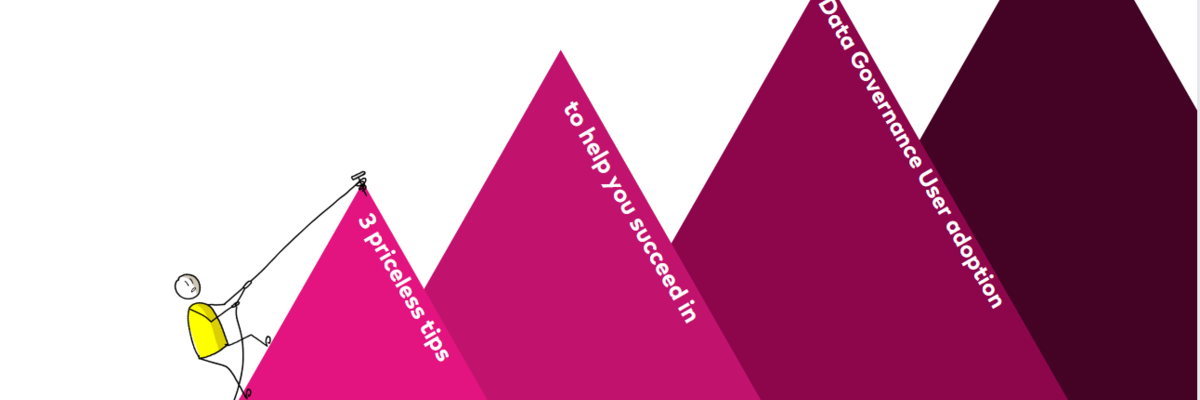3 priceless tips to help you succeed in Data Governance user adoption
10 November 2022

If you were to ask our Datashift consultants about the most challenging part of any Data Governance implementation, you would invariably hear the same answer: getting all stakeholders to participate. Data Governance is ultimately a collaborative process that can only be successful with the continued support of a thriving end-user community.
Any Data Governance implementation, therefore, hinges on user adoption. If end-users do not accept or use your Data Governance tool, it becomes useless. That’s why our consultants keep a clear goal in mind whenever they work with a client on a Data Governance project: deliver sustainable use cases that “live” throughout our client’s organization. From experience, they know that developing strong Data Governance use cases is one thing but keeping them alive for many years is entirely different.
So, what’s hindering Data Governance user adoption?
All too often, our consultants have seen clients succeed in setting up their Data Governance platform while struggling to expand its use beyond a limited group of end-users. They’ve repeatedly witnessed several conditions preventing a broad Data Governance user adoption, including
- a feeling that Data Governance brings extra work with no benefit for end-users,
- the reality that end-users simply give up because they don’t understand the Data Governance tool and fail to navigate through it,
- a missing sense of commitment among end-users to fulfill their Data Governance role responsibilities.
Fortunately, much can be done to boost Data Governance user adoption.
3 tips for a successful user adoption strategy
Note that we are talking about Collibra, as this is our most often implemented Data Governance Tool. However, these tips generally apply to all (Data Governance) Tools.
Tip 1: Always put the user first, and do it from the very beginning
No matter the use case, it will never work if the end-user doesn't understand or like it. So if you want end-users to actually start using a tool such as Collibra and make it part of their day-to-day jobs, the Data Governance implementation should cover their needs as much as the requirements of the Data Governance team.
You can empathize with the end-user's needs and expectations in many ways. Here are some proven DOs and DON’Ts to help you improve Data Governance user adoption..
- Speak the end-user’s language, and don’t use Collibra jargon during business meetings.
- Don’t overengineer the set-up of your customer landing pages in Collibra. Remember that end-users instantly want to see where they need to be and want to get there with as few clicks as possible.
- Create failure-proof step-by-step training materials that are consistently designed for all Collibra use cases. We have good experiences with our standard template that highlights the relevance of the use case (Why should you take this action in Collibra? What is the benefit for you? What is the benefit for the entire organization?) before continuing with a step-by-step procedure.
- Set up a support channel (either a Teams channel or a mailbox) so you can help end-users quickly if they cannot find their way around Collibra.
Tip 2: Focus on business value
Admit it: you cannot govern everything at once. Instead, see what generates the most value for your business and start with that. Just don’t forget to check what problem this solves for your end-users and how it will help them do a better job (after all, governance for governance’s sake is never a good idea). Does it work? That’s excellent because now you can move on and see what the next step should be to improve Data Governance user adoption.
But even if you start small, you need to do so with a strong foundation, creating a Roles & Responsibility framework that is airtight from the beginning. Make sure that all stakeholders accept this framework and that you have the follow-up mechanisms in place to ensure the completion of all responsibilities. If you want Data Governance to create value for your business, your content must remain up to date. That will only happen if end-users can be held accountable for their actions.
Tip 3: Evaluate, evaluate, evaluate, and never stop doing it
Evaluate your use cases and involve end-users to measure their success. Schedule regular feedback sessions with end-users to create a community feeling and show them what you’ve done with their feedback. Dare to change course or even stop if there is low business value. After all, what's the benefit if there is no business sponsor?
Evaluate your user base to understand Data Governance user adoption. Who is actually using your data governance tool? How does this compare to the roles & departments that should be using it? Where are the gaps?
Evaluate your Data Governance platform. Now that you know your end-user community, take a step back once in a while to check what services you offer them. Are they missing key pieces? Are you focusing on the right things? Make sure to look beyond individual use cases. Instead, look at your Data Governance platform as a whole and ask yourself, for example, where you want to be in a year or how many end-users you want to reach.
Need a hand?
Not sure what's the best approach to building a Data Governance user community? Are you looking for experience-based ideas and advice on improving Data Governance user adoption in your organization?
Check out our User Adoption training, or contact us for a 1-on-1 discussion.
